- Table of Contents
- Related Documents
-
| Title | Size | Download |
|---|---|---|
| 01-Text | 1.68 MB |
Temperature and humidity requirements· 1
Determining the installation position· 3
Mounting the AP on a ceiling· 7
Connecting the AP to the power source· 8
Connecting the PoE power supply· 8
Connecting the local power supply· 9
Connecting the AP to the network· 10
Appendix A Technical specifications· 12
Preparing for installation
Safety recommendations
| WARNING! Only qualified personnel can install and remove the AP and its accessories. You must read all safety instructions before installation and operation. |
To avoid possible bodily injury and equipment damage, read the following safety recommendations before installing the AP. Note that the recommendations do not cover every possible hazardous condition.
· Take adequate safety measures to avoid body injury and device damage.
· Place the AP in a dry and flat location and take anti-slip measures.
· Keep the AP clean and dust-free.
· Do not place the AP in a moist area and avoid liquid intrusion.
· Keep the AP and installation tools away from walkways.
Temperature and humidity requirements
Table 1 Temperature and humidity requirements
Item | Specification |
Operating temperature | 0°C to 45°C (32°F to 113°F) |
Storage temperature | –40°C to +70°C (–40°F to +158°F) |
Operating humidity | 5% RH to 95% RH, noncondensing |
Installation accessories
Figure 1 Accessories provided with the AP
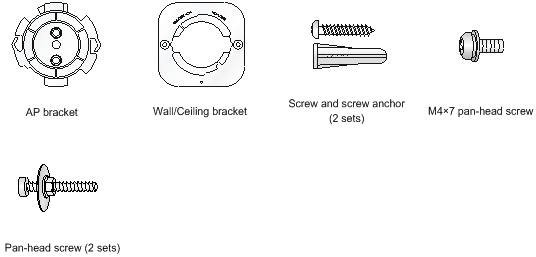
Installation tools
When installing the AP, you might need the following tools. Prepare the installation tools as required.
Figure 2 Installation tools
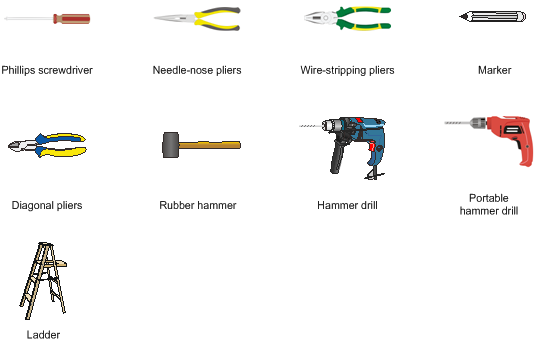
Installing the AP
Installation flowchart
Figure 3 Installation flowchart
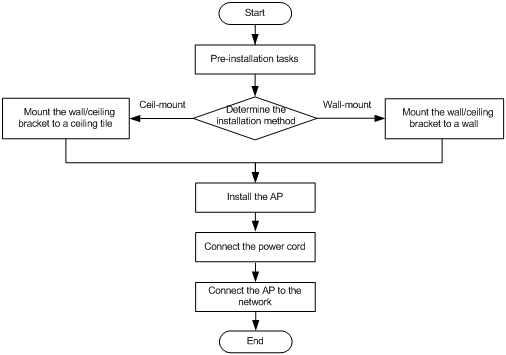
Pre-installation tasks
Before installing the AP, perform the following tasks:
· Connect the AP to a power source and the network. Examine the LEDs to verify that the AP operates correctly. For information about AP LEDs, see "LEDs."
· Record the MAC address and serial number at the rear of the AP for future use.
· Make sure you have completed cabling at the installation site.
Determining the installation position
Determine the installation position by observing the following principles:
· Few obstacles such as wall exist between the AP and clients.
· The AP is far away from electronic devices (such as microwave oven) that might generate radio frequency (RF) noise.
· The AP does not hinder people’s daily work and life.
· The place is not water seeping, water soaking, and condensing.
· The AP is more than 5 m (16.40 ft) away from 3G and 4G stations and antennas.
Installing the AP
The AP can be installed only indoors. You can mount the AP on a wall or a ceiling.
The mounting bracket kit for the AP includes an AP bracket and a wall/ceiling bracket. To install the AP on a wall or ceiling, attach the AP bracket to the AP and the wall/ceiling bracket to the wall or ceiling.
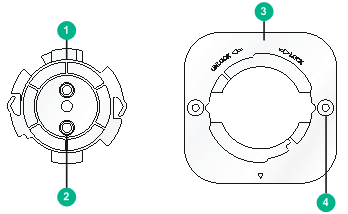
(1) AP bracket | (2) Alignment peg |
(3) Wall/Ceiling bracket | (4) Installation hole |
Figure 5 Wall/Ceiling bracket installation holes
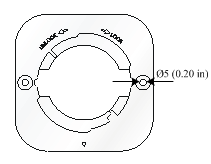
Mounting the AP on a wall
1. Set the alignment pegs on the AP bracket into the alignment holes in the AP rear. Use the M4 × 7 screw to secure the AP bracket to the AP through the installation hole in the middle of the AP bracket.
Figure 6 Attaching the AP bracket to the AP rear
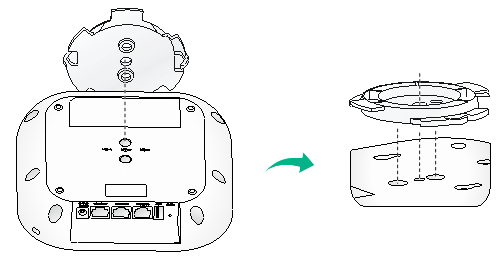
2. Mark the installation holes on the wall by using the wall/ceiling bracket, as shown in Figure 7.
Figure 7 Marking installation holes on the wall
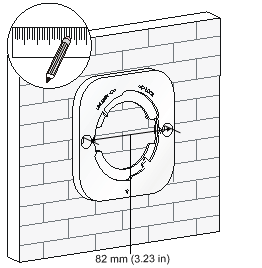
3. Drill holes with a diameter of 6 mm (0.24 in) and a depth of 30 mm (1.18 in) in the marked locations, as shown in Figure 8.
Figure 8 Drilling holes in the wall
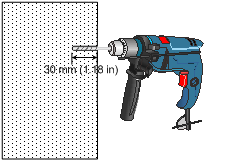
4. Insert a screw anchor into each hole, and tap the screw anchor with a rubber hammer until it is all flush with the wall surface, as shown in Figure 9.
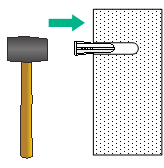
5. Align the installation holes in the wall/ceiling bracket with the anchors and insert screws through the installation holes into the screw anchors. Adjust the position of the wall/ceiling bracket and fasten the screws.
Figure 10 Attaching the wall/ceiling bracket to the wall
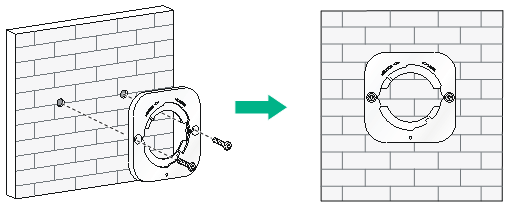
6. Align the two tabs on the AP bracket into the notches on the wall/ceiling bracket, and then rotate the AP clockwise until it snaps into place, as shown in Figure 11.
Figure 11 Attaching the AP to the wall/ceiling bracket
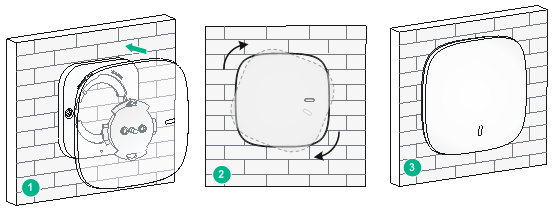
Mounting the AP on a ceiling
| CAUTION: The ceiling for installing the AP must be less than 18 mm (0.71 in) in thickness, and can bear a load of 5 kg (11.02 lb). If the ceiling is not strong enough, use boards to reinforce the ceiling as a best practice. |
To mount the AP on a ceiling:
1. Set the alignment pegs on the AP bracket into the alignment holes in the AP rear. Use the M4 × 7 screw to secure the AP bracket to the AP through the installation hole in the middle of the AP bracket.
2. Mark the installation holes on the ceiling by using the wall/ceiling bracket.
3. Drill two holes with a diameter of 5 mm (0.20 in) in the marked positions, as shown in Figure 12.
Figure 12 Drilling holes in the ceiling
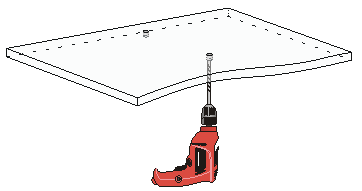
4. Thread the pan-head screws through the installation holes in the wall/ceiling bracket and into holes in the ceiling. Fasten washers and nuts at the other side of the ceiling to attach the wall/ceiling bracket to the ceiling, as shown in Figure 13.
Figure 13 Attaching the wall/ceiling bracket to the ceiling
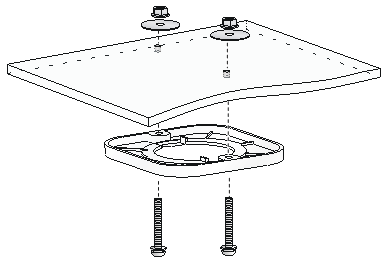
5. Align the AP with the wall/ceiling bracket and rotate the AP clockwise until it snaps into place, as shown in Figure 14. For more information, see "Mounting the AP on a wall."
Figure 14 Attaching the AP to the wall/ceiling bracket
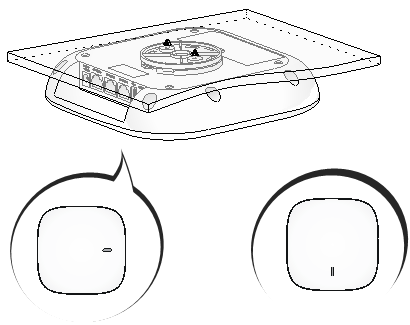
6. Verify that the AP is securely installed to prevent it from falling off.
Connecting the AP to the power source
The H3C WA538 supports 802.3at compliant PoE+ and local power supply.
Check before power-on
Check the following items before powering on the AP:
· To power the AP with local power, make sure the local power supply is reliably grounded.
· To power the AP through PoE, make sure the PoE power supply (PSE) is reliably grounded.
· To power the AP through PoE injector, make sure the PoE power supply (PSE) is reliably grounded.
· AP is to be connected only to PoE networks without routing to the outside plant.
Connecting the PoE power supply
| CAUTION: To use both Ethernet ports on the AP, connect an Ethernet cable to one port for PoE connection first, and then connect the other after the AP is powered on. |
Use an Ethernet cable to connect the Ethernet port on the AP to a port on a switch that supports PoE.
Figure 15 Connecting the PoE power supply
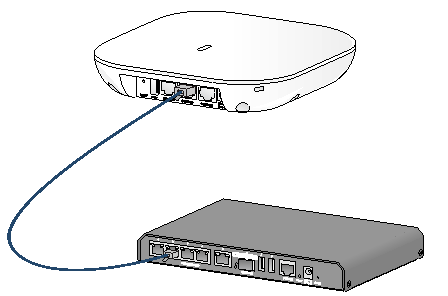
Connecting the local power supply
The Power adapter must be ordered separately.
Table 2 Power adapter specifications
Item | Specification |
Input | 100 VAC to 240 VAC |
Output | +54 VDC |
You can power the AP by using an power adapter. Use the power adapter to connect the power port of the AP to the local power source.
Connect the power adapter to the H3C WA538 as shown in Figure 16.
Figure 16 Connecting the local power supply
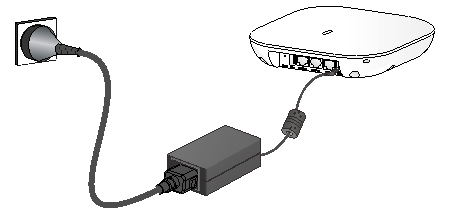
PoE injector power supply
| CAUTION: A PoE injector must be used together with an LPS-compliant adapter provided by H3C. |
The PoE injector must be ordered separately.
Connect the PoE injector to the AP and a switch with Ethernet cable. Use the power adapter to connect the power port of the PoE injector to the local power source.
Connect the PoE injector as shown in Figure 17
Figure 17 PoE injector power supply

Check after power-on
Verify that the AP is powered on and operating correctly by examining the AP status LED. For more information about AP LEDs, see "Appendix B Ports and LEDs."
Connecting the AP to the network
For Internet or MAN access, connect an Ethernet port on the AP to an Ethernet port on an Ethernet switch, and then verify that the AP has been connected to the network.
All AP settings are configured on the AC when the AP operates as a fit AP. Execute the display wlan ap all command on the AC. If the AP status is R/M, the AP is connected to the network.
<Sysname> display wlan ap all
Total number of APs: 1
Total number of connected APs: 1
Total number of connected manual APs: 1
Total number of connected auto APs: 0
Total number of connected common APs: 1
Total number of connected WTUs: 0
Total number of inside APs: 0
Maximum supported APs: 1024
Remaining APs: 1023
Total AP licenses: 128
Local AP licenses: 128
Server AP licenses: 0
Remaining local AP licenses: 127
Sync AP licenses: 0
AP information
State : I = Idle, J = Join, JA = JoinAck, IL = ImageLoad
C = Config, DC = DataCheck, R = Run M = Master, B = Backup
AP name APID State Model Serial ID
Appendix A Technical specifications
Table 3 Technical specifications
Item | H3C WA538 |
Protocol | · IEEE 802.11a/b/g/n/ac Wave2 · 802.3at/af |
Radio | Three |
Built-in antenna | · 2.4 G antenna: 5.30 dBi peak gain · 5 G antenna: 7.50 dBi peak gain · ble antenna: 5.02 dBi peak gain |
≤ 25 W | |
Dimensions (H × W × D) | 40 × 183 × 183 mm (1.57 × 7.20 × 7.20 in) |
Weight | 700 g (1.54 lb) |
Appendix B Ports and LEDs
Ports
The AP provides the following ports:
· One USB port
· One console port
· Two 10/100/1000 Mbps Ethernet copper ports
· One power port
The AP also has a reset button and a security slot. The security slot is 8 × 4 mm (0.31 × 0.16 in) in size.
Figure 18 Ports on the H3C WA538

(1) Reset button | (2) USB port | (3) Console port |
(4) 10/100/1000 Mbps Ethernet ports | (5) Power port | (6) Security slot |
Table 4 WA538 port description
Port | Standards and protocols | Description |
Console port | RS/EIA-232 | The console port is used for device configuration and management. |
GE1/PoE+ | · IEEE802.3 · IEEE802.3u · IEEE802.3af · IEEE802.3at | The GE1/0/1 port acts as an uplink interface to connect to the Internet or MAN. It also supports PoE. |
GE2/PoE+ | · IEEE802.3 · IEEE802.3u · IEEE802.3af · IEEE802.3at | The GE1/0/2 port acts as an uplink interface to connect to the Internet or MAN. It also supports PoE. |
Power port (54 VDC) | N/A | The power port receives +54 VDC power from the local power source. |
USB port | N/A | The USB port is USB 2.0 compliant. |
LEDs
Table 5 LED description
LED | Status | Description | ||
| Off | No power is present or the LED was turned off. | ||
Yellow | Steady on | The AP is initializing, or an initialization exception has occurred. | ||
Flashing at 1 Hz | No radio cards have been detected. | |||
Flashing at 2 Hz | The Ethernet interfaces are down and no mesh links are established. | |||
Green | Steady on | The AP has registered on an AC, but does not have any associated clients. | ||
Flashing at 0.5 Hz | The AP has started up but has not registered on any AC. | |||
Flashing at 1 Hz | Only the 2.4G radio has associated clients. | |||
Flashing at 2 Hz | The AP is upgrading the image. | |||
Blue | Flashing at 1 GHz | Only the 5G radio has associated clients. | ||
Alternating between green and blue at 1 Hz | Both the 2.4G and 5G radios have associated clients. | |||

